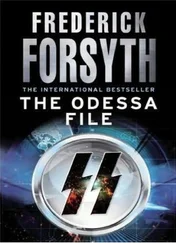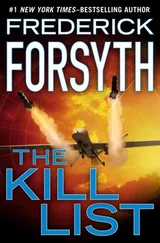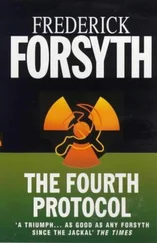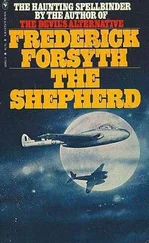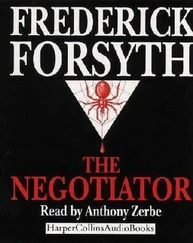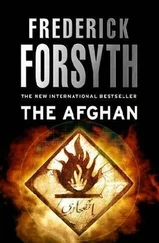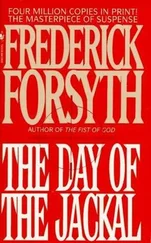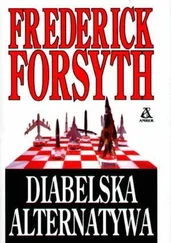Frederick Forsyth - The Devil's Alternative
Здесь есть возможность читать онлайн «Frederick Forsyth - The Devil's Alternative» весь текст электронной книги совершенно бесплатно (целиком полную версию без сокращений). В некоторых случаях можно слушать аудио, скачать через торрент в формате fb2 и присутствует краткое содержание. Жанр: Шпионский детектив, на английском языке. Описание произведения, (предисловие) а так же отзывы посетителей доступны на портале библиотеки ЛибКат.
- Название:The Devil's Alternative
- Автор:
- Жанр:
- Год:неизвестен
- ISBN:нет данных
- Рейтинг книги:5 / 5. Голосов: 1
-
Избранное:Добавить в избранное
- Отзывы:
-
Ваша оценка:
- 100
- 1
- 2
- 3
- 4
- 5
The Devil's Alternative: краткое содержание, описание и аннотация
Предлагаем к чтению аннотацию, описание, краткое содержание или предисловие (зависит от того, что написал сам автор книги «The Devil's Alternative»). Если вы не нашли необходимую информацию о книге — напишите в комментариях, мы постараемся отыскать её.
The Devil's Alternative — читать онлайн бесплатно полную книгу (весь текст) целиком
Ниже представлен текст книги, разбитый по страницам. Система сохранения места последней прочитанной страницы, позволяет с удобством читать онлайн бесплатно книгу «The Devil's Alternative», без необходимости каждый раз заново искать на чём Вы остановились. Поставьте закладку, и сможете в любой момент перейти на страницу, на которой закончили чтение.
Интервал:
Закладка:
The President went back to his other telephone, the red machine on which he was trying to speak directly to Maxim Rudin in Moscow.
At Andrews, the commander himself met the helicopter as it touched down. Without the presence of Robert Benson, whom the Air Force general knew by sight, it was unlikely he would have accepted the unknown Englishman as a passenger on the world’s fastest reconnaissance jet, let alone his orders to allow that jet to take off for Moscow. Ten years after it entered service, it was still on the secret list, so sophisticated were its components and systems.
“Very well, Mr. Director,” he said finally, “but I have to tell you that in Colonel O’Sullivan we have one very angry Arizonan.”
He was right. While Adam Munro was taken to the pilot clothing store to be issued with a g-suit, boots, and goldfish-bowl oxygen helmet, Robert Benson found Colonel George T. O’Sullivan in the navigation room, cigar clamped in his teeth, poring over maps of the Arctic and eastern Baltic. The Director of Central Intelligence might outrank him, but he was in no mood to be polite.
“Are you seriously ordering me to fly this bird clean across Greenland and Scandinavia, and into the heart of Rooshia?” he demanded truculently.
“No, Colonel,” said Benson reasonably. “The President of the United States is ordering you to do it.”
“Without my navigator-systems operator? With some goddam Limey sitting in his seat?”
“The ‘goddam Limey’ happens to bear a personal message from President Matthews to President Rudin of the USSR which has to reach him tonight and cannot be discussed in any other way,” said Benson.
The Air Force colonel stared at him for a moment.
“Well,” he conceded, “it better be goddam important.”
At twenty minutes before six, Adam Munro was led into the hangar where the aircraft stood, swarming with ground technicians preparing her to fly.
He had heard of the Lockheed SR-71, nicknamed the Blackbird due to its color; he had seen pictures of it, but never the real thing. It was certainly impressive. On a single, thin nosewheel assembly, the bulletlike nose cone thrust upward at a shallow angle. Far down the fuselage, wafer-thin wings sprouted, delta-shaped, being both wings and tail controls all in one.
Almost at each wing tip, the engines were situated, sleek pods housing the Pratt and Whitney JT-11-D turbofans, each capable with afterburner of throwing out thirty-two thousand pounds of thrust Two knifelike rudders rose, one from atop each engine, to give directional control. Body and engines resembled three hypodermic syringes, linked only by the wing.
Small white U.S. stars in their white circles indicated its nationality; otherwise the SR-71 was black from nose to tail.
Ground assistants helped him into the narrow confines of the rear seat; he found himself sinking lower and lower until the side walls of the cockpit rose above his ears. When the canopy came down, it would be almost flush with the fuselage to cut down drag effect. Looking out, he would see only directly upward to the stars.
The man who should have occupied that seat would have understood the bewildering array of radar screens, electronic countermeasure systems, and camera controls, for the SR-71 was essentially a spy plane, designed and equipped to cruise at altitudes far beyond the reach of most interceptor fighters and rockets, photographing what it saw below.
Helpful hands linked the tubes sprouting from his suit to the aircraft’s systems: radio, oxygen, anti-g-force. He watched Colonel O’Sullivan lower himself into the seat in front of him and begin attaching his own life-support systems with accustomed ease. When the radio was connected, the Arizonan’s voice boomed in his ears.
“You Scotch, Mr. Munro?”
“Scottish, yes,” said Munro into his helmet.
“I’m Irish,” said the voice in his ears. “You a Catholic?”
“A what?”
“A Catholic, for chrissake.”
Munro thought for a moment. He was not really religious at all.
“No,” he said, “Church of Scotland.”
There was evident disgust up front.
“Jesus, twenty years in the United States Air Force and I get to chauffeur a Scotch Protestant.”
The triple-perspex canopy capable of withstanding the tremendous air-pressure differences of ultra-high-altitude flight was closed upon them. A hiss indicated the cabin was now fully pressurized. Drawn by a tractor somewhere ahead of the nosewheel, the SR-71 emerged from the hangar into the evening light.
Heard from inside the aircraft, the engines, once started, seemed to make only a low, whistling sound. Outside, the ground crew shuddered even in their earmuffs as the boom echoed through the hangars.
Colonel O’Sullivan secured immediate clearance for takeoff even while he was running through his seemingly innumerable pre-takeoff checks. At the start of the main runway, the Blackbird paused, rocked on its wheels as the colonel lined her up; then Munro heard his voice:
“Whatever God you pray to, start now, and hold tight.”
Something like a runaway train hit Munro squarely across the broad of the back; it was the molded seat in which he was strapped. He could see no buildings to judge his speed, just the pale blue sky above. When the jet reached 150 knots, the nose left the tarmac; half a second later the main wheels parted company, and O’Sullivan lifted the undercarriage into its bay.
Clean of encumbrances, the SR-71 tilted back until its jet efflux pipes were pointing directly down at Maryland, and it climbed. It climbed almost vertically, powering its way to the sky like a rocket, which was almost what it was. Munro was on his back, feet toward the sky, conscious only of the steady pressure of the seat on his spine as the Blackbird streaked toward a sky that was soon turning to dark blue, to violet, and finally to black.
In the front seat, Colonel O’Sullivan was navigating, which is to say, following the instructions flashed before him in digital display by the aircraft’s on-board computer. It was feeding him altitude, speed, rate of climb, course and heading, external and internal temperatures, engine and jet-pipe temperatures, oxygen flow rates, and approach to the speed of sound.
Somewhere below them, Philadelphia and New York went by like toy towns; over northern New York State they went through the sound barrier, still climbing and still accelerating. At eighty thousand feet, five miles higher than the Concorde flew, Colonel O’Sullivan cut out the afterburners and leveled his flight attitude.
Though it was still not quite sundown, the sky was a deep black, for at these altitudes there are so few air molecules from which the sun’s rays can reflect that there is no light. But there are still enough such molecules to cause skin friction on a plane like the Blackbird. Before the state of Maine and the Canadian frontier had passed beneath them, they had adopted a fast-cruise speed of almost three times the speed of sound. Before Munro’s amazed eyes, the black skin of the SR-71, made of pure titanium, began to glow cherry-red in the heat.
Within the cockpit, the aircraft’s own refrigeration system kept its occupants comfortably cool in their g-suits.
“Can I talk?” asked Munro.
“Sure,” said the pilot laconically.
“Where are we now?”
“Over the Gulf of St. Lawrence,” said O’Sullivan, “heading for Newfoundland.”
“How many miles to Moscow?”
“From Andrews, four thousand eight hundred fifty-six miles.”
“How long for the flight?”
“Three hours and fifty minutes.”
Munro calculated. They had taken off at six P.M. Washington time, eleven P.M. European time. That would be one A.M. in Moscow on Sunday, April 3. They would touch down at around five A.M. Moscow time. If Rudin agreed to his plan, and the Blackbird could bring him back to Berlin, they would gain two hours by flying the other way. There was just time to make Berlin by dawn.
Читать дальшеИнтервал:
Закладка:
Похожие книги на «The Devil's Alternative»
Представляем Вашему вниманию похожие книги на «The Devil's Alternative» списком для выбора. Мы отобрали схожую по названию и смыслу литературу в надежде предоставить читателям больше вариантов отыскать новые, интересные, ещё непрочитанные произведения.
Обсуждение, отзывы о книге «The Devil's Alternative» и просто собственные мнения читателей. Оставьте ваши комментарии, напишите, что Вы думаете о произведении, его смысле или главных героях. Укажите что конкретно понравилось, а что нет, и почему Вы так считаете.

